+ データを開く
データを開く
- 基本情報
基本情報
| 登録情報 | データベース: PDB / ID: 6p5i | ||||||
|---|---|---|---|---|---|---|---|
| タイトル | Structure of a mammalian 80S ribosome in complex with the Israeli Acute Paralysis Virus IRES (Class 1) | ||||||
 要素 要素 |
| ||||||
 キーワード キーワード | RIBOSOME / Israeli Acute Paralysis Virus / Internal Ribosome Entry Site / IRES / Small Ribosomal Subunit / 40S / Large Ribosomal Subunit / 60S / 80S | ||||||
| 機能・相同性 |  機能・相同性情報 機能・相同性情報ribosomal subunit / ubiquitin ligase inhibitor activity / positive regulation of signal transduction by p53 class mediator / 90S preribosome / phagocytic cup / rough endoplasmic reticulum / translation regulator activity / ribosomal small subunit export from nucleus / gastrulation / MDM2/MDM4 family protein binding ...ribosomal subunit / ubiquitin ligase inhibitor activity / positive regulation of signal transduction by p53 class mediator / 90S preribosome / phagocytic cup / rough endoplasmic reticulum / translation regulator activity / ribosomal small subunit export from nucleus / gastrulation / MDM2/MDM4 family protein binding / cytosolic ribosome / class I DNA-(apurinic or apyrimidinic site) endonuclease activity / DNA-(apurinic or apyrimidinic site) lyase / ribosomal large subunit biogenesis / maturation of LSU-rRNA from tricistronic rRNA transcript (SSU-rRNA, 5.8S rRNA, LSU-rRNA) / positive regulation of apoptotic signaling pathway / maturation of SSU-rRNA from tricistronic rRNA transcript (SSU-rRNA, 5.8S rRNA, LSU-rRNA) / maturation of SSU-rRNA / small-subunit processome / spindle / rRNA processing / antimicrobial humoral immune response mediated by antimicrobial peptide / rhythmic process / positive regulation of canonical Wnt signaling pathway / heparin binding / regulation of translation / large ribosomal subunit / ribosome binding / ribosomal small subunit biogenesis / ribosomal small subunit assembly / 5S rRNA binding / ribosomal large subunit assembly / small ribosomal subunit / small ribosomal subunit rRNA binding / large ribosomal subunit rRNA binding / cytosolic small ribosomal subunit / defense response to Gram-negative bacterium / perikaryon / killing of cells of another organism / cytosolic large ribosomal subunit / cytoplasmic translation / cell differentiation / tRNA binding / mitochondrial inner membrane / postsynaptic density / rRNA binding / structural constituent of ribosome / ribosome / translation / ribonucleoprotein complex / cell division / DNA repair / mRNA binding / apoptotic process / synapse / dendrite / centrosome / nucleolus / perinuclear region of cytoplasm / endoplasmic reticulum / Golgi apparatus / DNA binding / RNA binding / zinc ion binding / nucleus / cytosol / cytoplasm 類似検索 - 分子機能 | ||||||
| 生物種 |  Israeli acute paralysis virus (ウイルス) Israeli acute paralysis virus (ウイルス) | ||||||
| 手法 | 電子顕微鏡法 / 単粒子再構成法 / クライオ電子顕微鏡法 / 解像度: 3.1 Å | ||||||
 データ登録者 データ登録者 | Acosta-Reyes, F.J. / Neupane, R. / Frank, J. / Fernandez, I.S. | ||||||
| 資金援助 |  米国, 1件 米国, 1件
| ||||||
 引用 引用 |  ジャーナル: EMBO J / 年: 2019 ジャーナル: EMBO J / 年: 2019タイトル: The Israeli acute paralysis virus IRES captures host ribosomes by mimicking a ribosomal state with hybrid tRNAs. 著者: Francisco Acosta-Reyes / Ritam Neupane / Joachim Frank / Israel S Fernández /  要旨: Colony collapse disorder (CCD) is a multi-faceted syndrome decimating bee populations worldwide, and a group of viruses of the widely distributed Dicistroviridae family have been identified as a ...Colony collapse disorder (CCD) is a multi-faceted syndrome decimating bee populations worldwide, and a group of viruses of the widely distributed Dicistroviridae family have been identified as a causing agent of CCD. This family of viruses employs non-coding RNA sequences, called internal ribosomal entry sites (IRESs), to precisely exploit the host machinery for viral protein production. Using single-particle cryo-electron microscopy (cryo-EM), we have characterized how the IRES of Israeli acute paralysis virus (IAPV) intergenic region captures and redirects translating ribosomes toward viral RNA messages. We reconstituted two in vitro reactions targeting a pre-translocation and a post-translocation state of the IAPV-IRES in the ribosome, allowing us to identify six structures using image processing classification methods. From these, we reconstructed the trajectory of IAPV-IRES from the early small subunit recruitment to the final post-translocated state in the ribosome. An early commitment of IRES/ribosome complexes for global pre-translocation mimicry explains the high efficiency observed for this IRES. Efforts directed toward fighting CCD by targeting the IAPV-IRES using RNA-interference technology are underway, and the structural framework presented here may assist in further refining these approaches. | ||||||
| 履歴 |
|
- 構造の表示
構造の表示
| ムービー |
 ムービービューア ムービービューア |
|---|---|
| 構造ビューア | 分子:  Molmil Molmil Jmol/JSmol Jmol/JSmol |
- ダウンロードとリンク
ダウンロードとリンク
- ダウンロード
ダウンロード
| PDBx/mmCIF形式 |  6p5i.cif.gz 6p5i.cif.gz | 5.2 MB | 表示 |  PDBx/mmCIF形式 PDBx/mmCIF形式 |
|---|---|---|---|---|
| PDB形式 |  pdb6p5i.ent.gz pdb6p5i.ent.gz | 表示 |  PDB形式 PDB形式 | |
| PDBx/mmJSON形式 |  6p5i.json.gz 6p5i.json.gz | ツリー表示 |  PDBx/mmJSON形式 PDBx/mmJSON形式 | |
| その他 |  その他のダウンロード その他のダウンロード |
-検証レポート
| 文書・要旨 |  6p5i_validation.pdf.gz 6p5i_validation.pdf.gz | 1.9 MB | 表示 |  wwPDB検証レポート wwPDB検証レポート |
|---|---|---|---|---|
| 文書・詳細版 |  6p5i_full_validation.pdf.gz 6p5i_full_validation.pdf.gz | 2 MB | 表示 | |
| XML形式データ |  6p5i_validation.xml.gz 6p5i_validation.xml.gz | 332.5 KB | 表示 | |
| CIF形式データ |  6p5i_validation.cif.gz 6p5i_validation.cif.gz | 576.2 KB | 表示 | |
| アーカイブディレクトリ |  https://data.pdbj.org/pub/pdb/validation_reports/p5/6p5i https://data.pdbj.org/pub/pdb/validation_reports/p5/6p5i ftp://data.pdbj.org/pub/pdb/validation_reports/p5/6p5i ftp://data.pdbj.org/pub/pdb/validation_reports/p5/6p5i | HTTPS FTP |
-関連構造データ
- リンク
リンク
- 集合体
集合体
| 登録構造単位 | 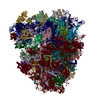
|
|---|---|
| 1 |
|
- 要素
要素
-RNA鎖 , 5種, 5分子 21578
| #1: RNA鎖 | 分子量: 602776.875 Da / 分子数: 1 / 由来タイプ: 天然 / 由来: (天然)  |
|---|---|
| #35: RNA鎖 | 分子量: 81572.078 Da / 分子数: 1 / 由来タイプ: 組換発現 詳細: Cell Free Synthesis. The RNA molecule was made in vitro 由来: (組換発現)  Israeli acute paralysis virus (ウイルス) Israeli acute paralysis virus (ウイルス)発現宿主: Synthetic construct (人工物) |
| #36: RNA鎖 | 分子量: 1164741.875 Da / 分子数: 1 / 由来タイプ: 天然 / 由来: (天然)  |
| #37: RNA鎖 | 分子量: 38385.750 Da / 分子数: 1 / 由来タイプ: 天然 / 由来: (天然)  |
| #38: RNA鎖 | 分子量: 50143.648 Da / 分子数: 1 / 由来タイプ: 天然 / 由来: (天然)  |
+タンパク質 , 75種, 75分子 BCDEFGHIJKLMNOPQRSTUVWXYZabcde...
-タンパク質・ペプチド , 1種, 1分子 An
| #77: タンパク質・ペプチド | 分子量: 3473.451 Da / 分子数: 1 / 由来タイプ: 天然 / 由来: (天然)  |
|---|
-詳細
| Has protein modification | Y |
|---|
-実験情報
-実験
| 実験 | 手法: 電子顕微鏡法 |
|---|---|
| EM実験 | 試料の集合状態: PARTICLE / 3次元再構成法: 単粒子再構成法 |
- 試料調製
試料調製
| 構成要素 | 名称: Structure of a mammalian 80S ribosome in complex with the Israeli Acute Paralysis Virus IRES (Class 1) タイプ: RIBOSOME / Entity ID: all / 由来: MULTIPLE SOURCES | ||||||||||||||||||||
|---|---|---|---|---|---|---|---|---|---|---|---|---|---|---|---|---|---|---|---|---|---|
| 分子量 | 実験値: NO | ||||||||||||||||||||
| 由来(天然) | 生物種:  | ||||||||||||||||||||
| 緩衝液 | pH: 7.5 | ||||||||||||||||||||
| 緩衝液成分 |
| ||||||||||||||||||||
| 試料 | 包埋: NO / シャドウイング: NO / 染色: NO / 凍結: YES 詳細: Ribosomal complexes for the pre-translocated state were assembled at 240-390 nM concentration and applied to plasma treated holey carbon. | ||||||||||||||||||||
| 試料支持 | 詳細: Plasma cleaning for both holey carbon and holey gold grids was done on a Gatan Solarus with Hydrogen (6.4 sccm gas flow) and Oxygen (27.5 sccm gas flow) and 10 W cleaning power. グリッドの材料: COPPER / グリッドのタイプ: Quantifoil R2/2 | ||||||||||||||||||||
| 急速凍結 | 装置: FEI VITROBOT MARK IV / 凍結剤: ETHANE / 湿度: 100 % / 凍結前の試料温度: 277.15 K 詳細: Blot force = 3s Wait time = 15s Drain time = 0s Blot time = 2.5 to 3 s |
- 電子顕微鏡撮影
電子顕微鏡撮影
| 実験機器 |  モデル: Tecnai F30 / 画像提供: FEI Company |
|---|---|
| 顕微鏡 | モデル: FEI TECNAI F30 |
| 電子銃 | 電子線源:  FIELD EMISSION GUN / 加速電圧: 300 kV / 照射モード: OTHER FIELD EMISSION GUN / 加速電圧: 300 kV / 照射モード: OTHER |
| 電子レンズ | モード: BRIGHT FIELD / 倍率(公称値): 31000 X / 最大 デフォーカス(公称値): 2500 nm / 最小 デフォーカス(公称値): 800 nm / Cs: 2.26 mm |
| 試料ホルダ | 凍結剤: NITROGEN |
| 撮影 | 平均露光時間: 8 sec. / 電子線照射量: 42.09 e/Å2 / 検出モード: COUNTING フィルム・検出器のモデル: GATAN K2 SUMMIT (4k x 4k) 実像数: 11234 |
| 画像スキャン | 横: 3710 / 縦: 3838 / 動画フレーム数/画像: 40 / 利用したフレーム数/画像: 1-40 |
- 解析
解析
| EMソフトウェア |
| |||||||||||||||||||||
|---|---|---|---|---|---|---|---|---|---|---|---|---|---|---|---|---|---|---|---|---|---|---|
| CTF補正 | タイプ: PHASE FLIPPING AND AMPLITUDE CORRECTION | |||||||||||||||||||||
| 粒子像の選択 | 選択した粒子像数: 1240275 | |||||||||||||||||||||
| 対称性 | 点対称性: C1 (非対称) | |||||||||||||||||||||
| 3次元再構成 | 解像度: 3.1 Å / 解像度の算出法: FSC 0.143 CUT-OFF / 粒子像の数: 120176 / 対称性のタイプ: POINT |
 ムービー
ムービー コントローラー
コントローラー














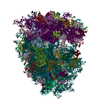

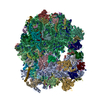
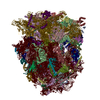

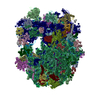
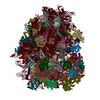

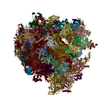
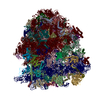
 PDBj
PDBj






























